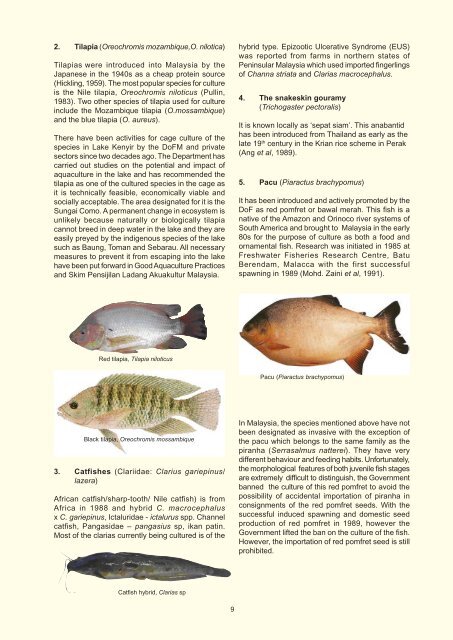7. Issues and Challenges in Aquatic Invasive Alien Species - Seafdec
7. Issues and Challenges in Aquatic Invasive Alien Species - Seafdec
7. Issues and Challenges in Aquatic Invasive Alien Species - Seafdec
You also want an ePaper? Increase the reach of your titles
YUMPU automatically turns print PDFs into web optimized ePapers that Google loves.
2. Tilapia (Oreochromis mozambique,O. nilotica)<br />
Tilapias were <strong>in</strong>troduced <strong>in</strong>to Malaysia by the<br />
Japanese <strong>in</strong> the 1940s as a cheap prote<strong>in</strong> source<br />
(Hickl<strong>in</strong>g, 1959). The most popular species for culture<br />
is the Nile tilapia, Oreochromis niloticus (Pull<strong>in</strong>,<br />
1983). Two other species of tilapia used for culture<br />
<strong>in</strong>clude the Mozambique tilapia (O.mossambique)<br />
<strong>and</strong> the blue tilapia (O. aureus).<br />
There have been activities for cage culture of the<br />
species <strong>in</strong> Lake Kenyir by the DoFM <strong>and</strong> private<br />
sectors s<strong>in</strong>ce two decades ago. The Department has<br />
carried out studies on the potential <strong>and</strong> impact of<br />
aquaculture <strong>in</strong> the lake <strong>and</strong> has recommended the<br />
tilapia as one of the cultured species <strong>in</strong> the cage as<br />
it is technically feasible, economically viable <strong>and</strong><br />
socially acceptable. The area designated for it is the<br />
Sungai Como. A permanent change <strong>in</strong> ecosystem is<br />
unlikely because naturally or biologically tilapia<br />
cannot breed <strong>in</strong> deep water <strong>in</strong> the lake <strong>and</strong> they are<br />
easily preyed by the <strong>in</strong>digenous species of the lake<br />
such as Baung, Toman <strong>and</strong> Sebarau. All necessary<br />
measures to prevent it from escap<strong>in</strong>g <strong>in</strong>to the lake<br />
have been put forward <strong>in</strong> Good Aquaculture Practices<br />
<strong>and</strong> Skim Pensijilan Ladang Akuakultur Malaysia.<br />
hybrid type. Epizootic Ulcerative Syndrome (EUS)<br />
was reported from farms <strong>in</strong> northern states of<br />
Pen<strong>in</strong>sular Malaysia which used imported f<strong>in</strong>gerl<strong>in</strong>gs<br />
of Channa striata <strong>and</strong> Clarias macrocephalus.<br />
4. The snakesk<strong>in</strong> gouramy<br />
(Trichogaster pectoralis)<br />
It is known locally as ‘sepat siam’. This anabantid<br />
has been <strong>in</strong>troduced from Thail<strong>and</strong> as early as the<br />
late 19 th century <strong>in</strong> the Krian rice scheme <strong>in</strong> Perak<br />
(Ang et al, 1989).<br />
5. Pacu (Piaractus brachypomus)<br />
It has been <strong>in</strong>troduced <strong>and</strong> actively promoted by the<br />
DoF as red pomfret or bawal merah. This fish is a<br />
native of the Amazon <strong>and</strong> Or<strong>in</strong>oco river systems of<br />
South America <strong>and</strong> brought to Malaysia <strong>in</strong> the early<br />
80s for the purpose of culture as both a food <strong>and</strong><br />
ornamental fish. Research was <strong>in</strong>itiated <strong>in</strong> 1985 at<br />
Freshwater Fisheries Research Centre, Batu<br />
Berendam, Malacca with the first successful<br />
spawn<strong>in</strong>g <strong>in</strong> 1989 (Mohd. Za<strong>in</strong>i et al, 1991).<br />
Red tilapia, Tilapia niloticus<br />
Pacu (Piaractus brachypomus)<br />
Black tilapia, Oreochromis mossambique<br />
3. Catfishes (Clariidae: Clarius gariep<strong>in</strong>us/<br />
lazera)<br />
African catfish/sharp-tooth/ Nile catfish) is from<br />
Africa <strong>in</strong> 1988 <strong>and</strong> hybrid C. macrocephalus<br />
x C. gariep<strong>in</strong>us, Ictaluridae - ictalurus spp. Channel<br />
catfish, Pangasidae – pangasius sp, ikan pat<strong>in</strong>.<br />
Most of the clarias currently be<strong>in</strong>g cultured is of the<br />
In Malaysia, the species mentioned above have not<br />
been designated as <strong>in</strong>vasive with the exception of<br />
the pacu which belongs to the same family as the<br />
piranha (Serrasalmus natterei). They have very<br />
different behaviour <strong>and</strong> feed<strong>in</strong>g habits. Unfortunately,<br />
the morphological features of both juvenile fish stages<br />
are extremely difficult to dist<strong>in</strong>guish, the Government<br />
banned the culture of this red pomfret to avoid the<br />
possibility of accidental importation of piranha <strong>in</strong><br />
consignments of the red pomfret seeds. With the<br />
successful <strong>in</strong>duced spawn<strong>in</strong>g <strong>and</strong> domestic seed<br />
production of red pomfret <strong>in</strong> 1989, however the<br />
Government lifted the ban on the culture of the fish.<br />
However, the importation of red pomfret seed is still<br />
prohibited.<br />
Catfish hybrid, Clarias sp<br />
9

















